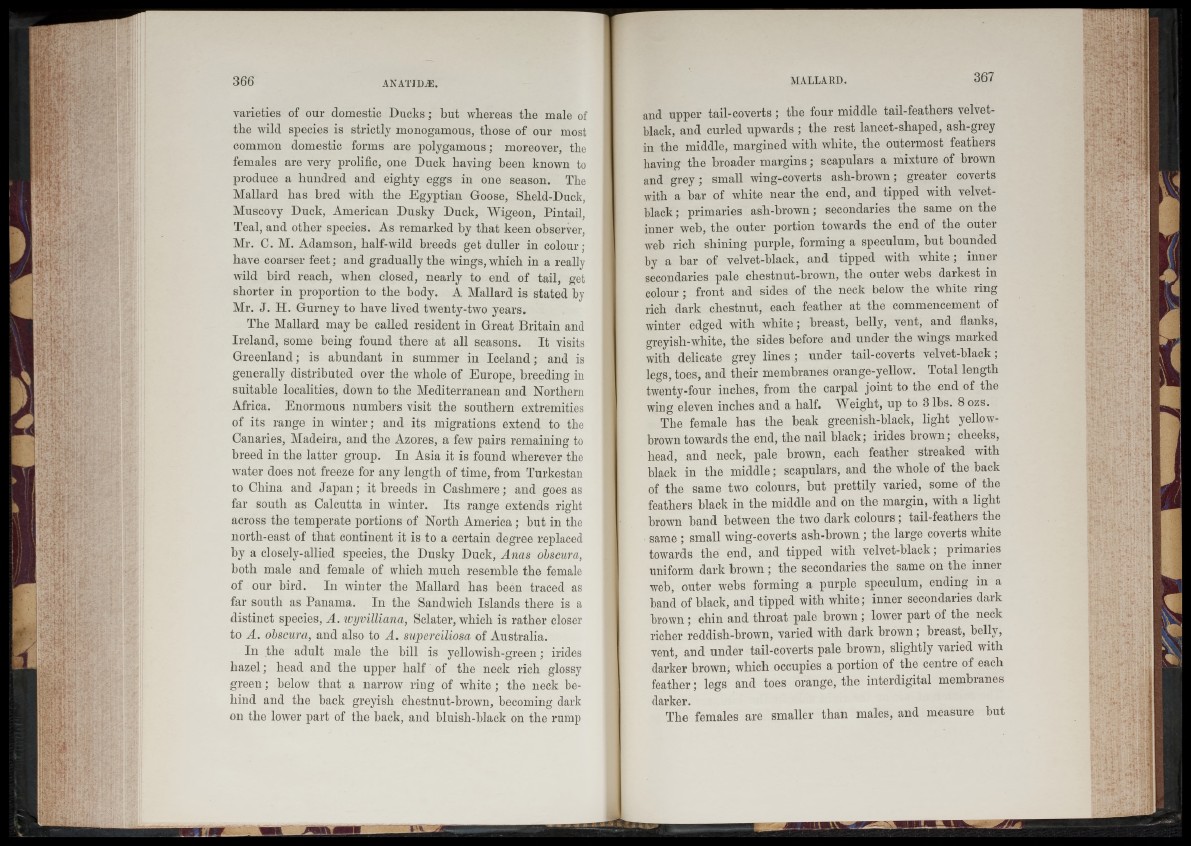
varieties of our domestic Ducks; but whereas the male of
the wild species is strictly monogamous, those of our most
common domestic forms are polygamous; moreover, the
females are very prolific, one Duck having been known to
produce a hundred and eighty eggs in one season. The
Mallard has bred with the Egyptian Goose, Sheld-Duck,
Muscovy Duck, American Dusky Duck, Wigeon, Pintail,
Teal, and other species. As remarked by that keen observer,
Mr. C. M. Adamson, half-wild breeds get duller in colour ;
have coarser feet; and gradually the wings, which in a really
wild bird reach, when closed, nearly to end of tail, get
shorter in proportion to the body. A Mallard is stated by
Mr. J. EE. Gurney to have lived twenty-two years.
The Mallard may be called resident in Great Britain and
Ireland, some being found there at all seasons. It visits
Greenland; is abundant in summer in Iceland; and is
generally distributed over the whole of Europe, breeding in
suitable localities, down to the Mediterranean and Northern
Africa. Enormous numbers visit the southern extremities
of its range in winter; and its migrations extend to the
Canaries, Madeira, and the Azores, a few pairs remaining to
breed in the latter group. In Asia it is found wherever the
water does not freeze for any length of time, from Turkestan
to China and Japan; it breeds in Cashmere; and goes as
far south as Calcutta in winter. Its range extends right
across the temperate portions of North America; but in the
north-east of that continent it is to a certain degree replaced
by a closely-allied species, the Dusky Duck, Anas obscura,
both male and female of which much resemble the female
of our bird. In winter the Mallard has been traced as
far south as Panama. In the Sandwich Islands there is a
distinct species, A. wyvilliana, Sclater, which is rather closer
to A. obscura, and also to A. superciliosa of Australia.
In the adult male the bill is yellowish-green; irides
hazel; head and the upper half of the neck rich glossy
green; below that a narrow ring of white ; the neck behind
and the back greyish cliestnut-brown, becoming dark
on the lower part of the back, and bluisli-black on the rump
and upper tail-coverts ; the four middle tail-feathers velvet-
black, and curled upwards ; the rest lancet-shaped, ash-grey
in the middle, margined with white, the outermost feathers
having the broader margins; scapulars a mixture of brown
and grey; small wing-coverts ash-brown; greater coverts
with a bar of white near the end, and tipped with velvet-
black ; primaries asli-brown; secondaries the same on the
inner web, the outer portion towards the end of the outei
web rich shining purple, forming a speculum, but bounded
by a bar of velvet-black, and tipped with white; inner
secondaries pale chestnut-brown, the outer webs darkest in
colour ; front and sides of the neck below the white ring
rich dark chestnut, each feather at the commencement of
winter edged with white; breast, belly, vent, and flanks,
greyish-white, the sides before and under the wings marked
with delicate grey lines ; under tail-coverts velvet-black;
legs, toes, and their membranes orange-yellow. Total length
twenty-four inches, from the carpal joint to the end of the
wing eleven inches and a half. Weight, up to 3 lbs. 8 ozs.
The female has the beak greenish-black, light yellow-
brown towards the end, the nail black; irides brown; cheeks,
head, and neck, pale brown, each feather streaked with
black in the middle; scapulars, and the whole of the back
of the same two colours, but prettily varied, some of the
feathers black in the middle and on the margin, with a light
brown band between the two dark colours; tail-featners the
same ; small wing-coverts ash-brown ; the large coverts white
towards the end, and tipped with velvet-black; primaries
uniform dark brown; the secondaries the same on the inner
web, outer webs forming a purple speculum, ending in a
band of black, and tipped with white; inner secondaries dark
brown ; chin and throat pale brown ; lower part of the neck
richer reddish-brown, varied with dark brown ; breast, belly,
vent, and under tail-coverts pale brown, slightly varied with
darker brown, which occupies a portion of the centre of each
feather; legs and toes orange, the interdigital membranes
darker.
The females are smaller than males, and measure but